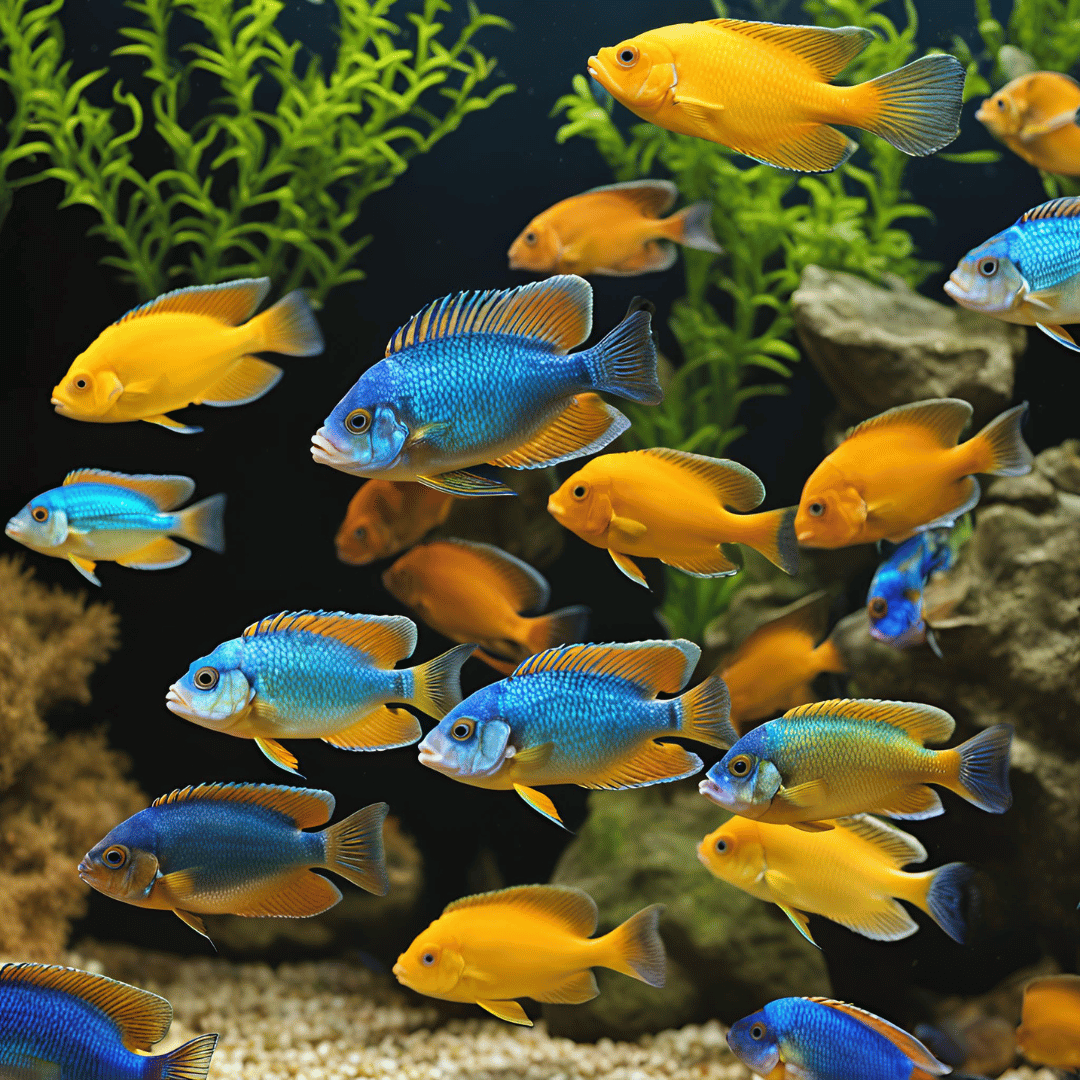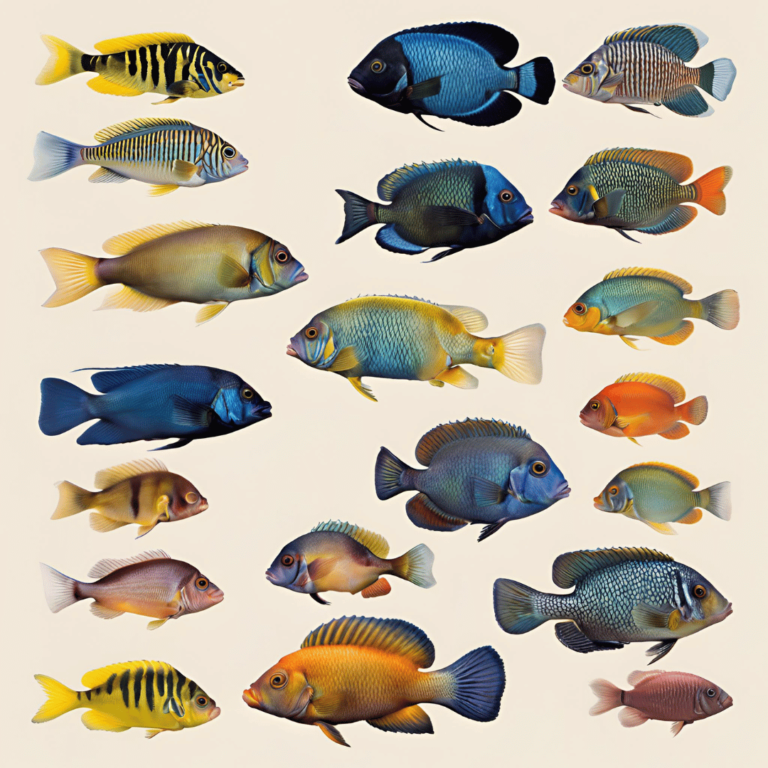Your trusted guide to cichlid care, tank setups, and quality products.

7 Powerful Tips for Transporting Peacock Cichlids Safely
Moving your peacock cichlids? Our comprehensive guide provides essential tips for safe transportation, ensuring your beloved fish arrive at their new home healthy and stress-free.
Image credits Canva
Transporting peacock cichlids can be a delicate task, whether you’re relocating them to a new tank, moving to a new home, or simply taking them to a fellow aquarist. These vibrant and captivating fish require careful handling to minimize stress and ensure their well-being. In this comprehensive guide, we’ll explore seven powerful tips to help you master the art of transporting peacock cichlids safely and effectively.
At PeacockCichlid.com, we believe in transparency and honesty with our readers. Some of the links in this article are affiliate links, which means we may earn a small commission if you make a purchase through them—at no additional cost to you. These commissions help support our site, allowing us to continue providing expert advice, in-depth guides, and valuable content for Peacock Cichlid enthusiasts like you.
We only recommend products that we trust and believe will be beneficial for your aquarium. Thank you for your support!
Why Proper Transport is Crucial for Transporting Peacock Cichlids
Peacock cichlids, known for their striking colors and active personalities, are surprisingly sensitive to stress during transit. Stress can weaken their immune systems, making them more susceptible to illness and injury. Improper transport conditions, such as fluctuating temperatures or poor water quality, can cause lasting harm.
By carefully planning and executing the process, you can ensure your fish remain healthy, vibrant, and stress-free. Additionally, poor transport practices can negatively impact other cichlids in shared tanks. These fish, too, are sensitive to stress and water quality changes, making proper handling a necessity for maintaining harmony and health among all aquatic inhabitants.
1. Set Up Your New Tank in Advance for Transporting Peacock Cichlids
If you’re moving your peacock cichlids to a new aquarium, preparation is everything. Ensure the new tank is fully cycled and that water parameters—such as pH, temperature, and quality—match those of their current habitat. This step minimizes the risk of shock during acclimation.
Transporting peacock cichlids becomes significantly safer when they’re moved into a well-prepared environment that feels familiar and stable. This also reduces potential stress on other cichlids that may already reside in the new tank, creating a harmonious transition.
2. Use Proper Fish Transport Equipment for Transporting Peacock Cichlids
Having the right tools is crucial for transporting peacock cichlids safely. Here’s what you’ll need:
- Fish transport bags: Thick, durable bags that can hold water securely. Double-bagging is highly recommended to prevent leaks.
- Styrofoam boxes or coolers: These are excellent for insulating and maintaining stable temperatures during transit.
- Air pump or oxygen supply: Oxygenating the water is especially important for long trips to ensure your fish can breathe easily.
Investing in quality equipment not only ensures a smoother journey for your cichlids but also provides peace of mind for you. Proper equipment is equally vital when transporting other cichlids, as they share similar needs for stable, stress-free transit conditions.
3. Fast Your Fish Before Transporting Peacock Cichlids
Feeding your fish before transport might seem like a good idea, but it’s actually counterproductive. Fasting peacock cichlids for 24-48 hours before the move helps reduce waste in the water during the journey.
This keeps the water cleaner and reduces the risk of ammonia build-up. Don’t worry—peacock cichlids can tolerate this fasting period without any harm. Following this practice also benefits other cichlids if they’re being transported together, keeping the water environment stable and healthy.
4. Handle Your Cichlids with Care During Transport
The way you handle your fish during capture and transfer can make a significant difference. When catching your cichlids:
- Use a soft fish net to avoid injury.
- Remove any tank décor to create a clear space for easy capture.
- Avoid sudden movements to keep your fish calm.
Handling peacock cichlids gently and patiently is key to reducing stress and ensuring their safety. These methods also apply when handling other cichlids, as they, too, can be prone to stress and injury during transfer. Ensuring careful handling sets the tone for a successful journey.
5. Pack Your Fish Securely for Transporting Peacock Cichlids
Proper packing is essential for successful transport. Follow these steps:
- Fill transport bags halfway with water from the tank. Ensure there’s enough space for oxygen above the water line.
- Carefully place your cichlids in the bags, using a soft net for transfer.
- Use an oxygen pump for longer trips to keep the water well-oxygenated.
- Seal the bags tightly and place them inside a Styrofoam box to insulate and protect against temperature fluctuations.
This method of packing ensures that transporting peacock cichlids is safe and minimizes the risk of accidents. If transporting other cichlids alongside them, ensure compatibility to avoid conflicts during transit. Proper packing techniques are a cornerstone of fish transportation success.
6. Minimize Transport Time When Transporting Peacock Cichlids
Time spent in transit can significantly affect the well-being of your cichlids. Plan your route carefully to reduce travel time. For long-distance journeys, consider these extra precautions:
- Carry a portable air pump to maintain oxygen levels.
- Use breather bags, which allow for the exchange of gases without additional equipment.
- Monitor the water temperature and quality periodically.
The quicker and more stable the journey, the better the outcome when transporting peacock cichlids. These precautions also ensure a safer experience for other cichlids sharing the journey. Time management and preparation are key factors in achieving a successful move.
7. Acclimate Your Fish Gradually After Transporting Peacock Cichlids
Once you arrive at your destination, acclimating your fish to their new environment is crucial. Follow these steps:
- Float the sealed transport bags in the new tank for 20-30 minutes. This helps equalize the temperature.
- Slowly add small amounts of tank water to the bag every 10 minutes.
- After 30-45 minutes, gently release the cichlids into the tank.
This gradual acclimation process prevents shock and helps your fish adjust to their new surroundings comfortably. Proper acclimation is particularly important for peacock cichlids and other cichlids, as both species are sensitive to rapid environmental changes. Ensuring a smooth transition helps them thrive in their new habitat.
Additional Tips for Long-Distance Transport of Peacock Cichlids
Transporting peacock cichlids over long distances requires extra attention. Here are some additional tips:
- Use ammonia neutralizers: These can detoxify waste build-up in the transport water.
- Check water quality regularly: Test for temperature, pH, and ammonia levels.
- Perform partial water changes: If the journey is especially long, change a portion of the water to keep it fresh.
These precautions can make a world of difference in ensuring the safety of your fish during extended travel. They are equally beneficial when transporting other cichlids over long distances. Every detail counts when it comes to long-haul fish transportation.
Post-Transport Care for Transporting Peacock Cichlids
After transporting peacock cichlids, closely monitor them for any signs of stress or illness. Common indicators include:
- Loss of color: This often occurs due to stress but should resolve within a few days.
- Erratic swimming or lethargy: Signs of residual stress or possible injury.
- Water quality issues: Regular testing ensures a smooth recovery period.
Providing a calm and stable environment will help your fish recover quickly and thrive in their new home. Regular care also ensures that other cichlids in the tank remain healthy and stress-free. Ongoing observation and adjustments are essential to maintaining a balanced aquarium environment.
Common Mistakes to Avoid When Transporting Peacock Cichlids
When transporting peacock cichlids, avoid these pitfalls:
- Skipping acclimation: Always acclimate your fish to their new tank.
- Using low-quality transport bags: Invest in durable bags to prevent leaks and accidents.
- Neglecting temperature control: Insulating your fish properly protects them from harmful temperature extremes.
By steering clear of these mistakes, you’ll protect both peacock cichlids and other cichlids from unnecessary stress and harm. Thoughtful preparation and execution can make all the difference in achieving a smooth move.
Conclusion
Transporting peacock cichlids doesn’t have to be stressful. By following these seven powerful tips, you can ensure their safety and health throughout the journey. From preparing the right equipment to carefully acclimating them to their new tank, every step is crucial. By prioritizing their well-being, you’ll not only protect your fish but also enjoy a rewarding experience as an aquarist.
Share these best practices with fellow enthusiasts and make transporting peacock cichlids a seamless process. Empower your journey with knowledge and ensure these vibrant fish continue to thrive.
If you found our guide on safely transporting your Peacock Cichlids helpful, why not explore more ways to elevate your aquarium care? Enhance your routine with our article Peacock Cichlid Tank Maintenance: 14 Proven Tips for Success for daily upkeep strategies, or learn to sidestep common pitfalls by reading Top 10 Mistakes to Avoid When Keeping Peacock Cichlids. Additionally, discover early signs of stress and how to prevent them in 10 Signs of Peacock Cichlid Stress and How to Prevent It to ensure your fish always thrive.
At peacochcichlid.com, we’re dedicated to helping you master every aspect of care and maintenance. We look forward to welcoming you back for more expert insights, so be sure to follow us on social media for the latest tips and trends in aquarium care!
FAQ’s
How do I prepare peacock cichlids for transport?
Prepare peacock cichlids by fasting them for 24-48 hours, ensuring clean water in the transport bags, and maintaining stable water parameters similar to their tank.
Can peacock cichlids tolerate long-distance transport?
Yes, peacock cichlids can handle long-distance transport if proper measures like oxygenation, insulation, and water quality monitoring are taken.
What equipment is essential for transporting peacock cichlids?
Key equipment includes fish transport bags, Styrofoam boxes, an air pump, and ammonia neutralizers to ensure safe travel.
Should I feed my peacock cichlids before transporting them?
No, feeding before transport can lead to waste build-up in the water. Fasting your fish reduces the risk of ammonia spikes during the journey.
How do I reduce stress for peacock cichlids during transit?
Minimize stress by handling them gently, using insulated containers to maintain temperature, and ensuring oxygenation in the transport water.
Can I transport peacock cichlids with other cichlids?
Yes, but ensure compatibility and adequate space to prevent stress or aggression during the trip. Proper planning is essential.
What precautions should I take for long journeys?
Use oxygen pumps, breather bags, and periodically check water quality to keep your peacock cichlids safe on long trips.
How do I acclimate peacock cichlids after transport?
Float the transport bag in the new tank to equalize temperature, then gradually mix tank water into the bag before releasing the fish.
What are common mistakes when transporting peacock cichlids?
Avoid skipping acclimation, using poor-quality bags, or neglecting temperature control. These errors can harm your fish.
Can improper transport affect the health of other cichlids in the same tank?
Yes, improper transport of peacock cichlids can introduce stress or contaminants that may impact other cichlids in the tank.



